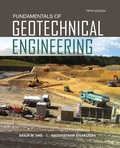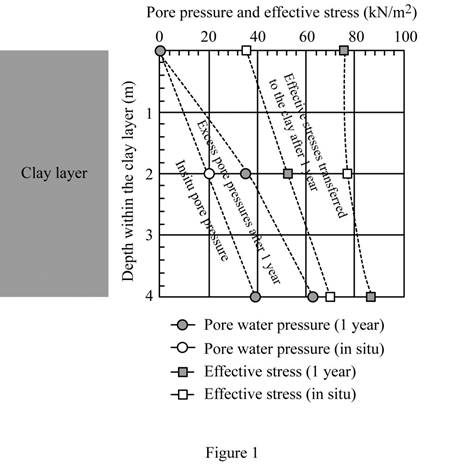
Concept explainers
(a)
Calculate the consolidation settlement inone year.
(a)
Answer to Problem 9.20CTP
The consolidation settlement in one year
Explanation of Solution
Given information:
The thickness of sand layer
The thickness of clay layer
The moisture content
The specific gravity of soil solids
The compression index
The coefficient of consolidation
The unit weight of sand is
The unit weight of fill
The depth of the compacted fill
Calculation:
Consider the unit weight of water
Calculate the initial void ratio
Substitute
Calculate the saturated unit weight
Substitute
At the middle of the clay layer:
Calculate the effective overburden pressure
Substitute
Calculate the increase in vertical pressure
Substitute
Calculate the final primary consolidation settlement
Substitute
Calculate the time factor
Substitute
Refer Table 9.3 “Variation of Time Factor with Degree of consolidation” in the Text Book.
Take the value of Uas
Take the value of Uas
Calculate the value of U for the value
Calculate the final consolidation settlement
Substitute
Therefore, the consolidation settlement in one year is
(b)
Plot the in situ variation of pore water pressure and effective stress with depth for the clay layer.
(b)
Explanation of Solution
Given information:
The thickness of sand layer
The thickness of clay layer
The moisture content
The specific gravity of soil solids
The compression index
The coefficient of consolidation
The unit weight of sand is
The unit weight of fill
The depth of the compacted fill
Calculation:
Calculate the total stress
Substitute
Calculate the pore water pressure
Substitute
Calculate the total stress
Substitute
Calculate the total stress
Substitute
Calculate the pore water pressure
Substitute
Calculate the total stress
Substitute
Show the variation of pore water pressure and effective stress with depth for the clay layer as in Figure 1.
(c)
Plot the variation of pore water pressure and effective stress with depth after on year.
(c)
Explanation of Solution
Given information:
The thickness of sand layer
The thickness of clay layer
The moisture content
The specific gravity of soil solids
The compression index
The coefficient of consolidation
The unit weight of sand is
The unit weight of fill
The depth of the compacted fill
Calculation:
Consider the degree of consolidation
Refer to part (a).
The time factor
Calculate the effective stress
Substitute
Calculate the pore water
Substitute
Calculate the ratio of height of soil to the maximum drainage depth as shown below.
Substitute
Refer Figure 9.20 “Variation of
Take the value of
Calculate the effective stress
Substitute
Calculate the pore water
Substitute
At the bottom of the clay layer, after one year:
Calculate the ratio of height of soil to the maximum drainage depth;
Substitute
Refer Figure 9.20 “Variation of
Take the value of
Calculate the effective stress
Substitute
Calculate the pore water
Substitute
Show the variation of the pore water pressure and the effective stress with depth as in Figure 1.

Want to see more full solutions like this?
Chapter 9 Solutions
EBK FUNDAMENTALS OF GEOTECHNICAL ENGINE
- please helparrow_forwardAS Q1/ The specific gravity of the soil is 1.41 percentage of water content by weight at field capacity and wilting point are 15% and 7% respectively calculate the equivalent moisture content as equivalent depth for 1.2m root zone : 1. at permanent wilting point 2. at field capacity 3. for ready available waterarrow_forwardQuestion 6 The following figure shows peak-hour volumes for an intersection. Using Webster's method, determine a suitable signal timing for the intersection using the four-phase system shown below. Use an amber interval of 3 seconds and the saturation flow given in the table. O 100 O Phase Lime Group Saturation Flow A e 1615-> 370 3700 B 1615 1615 3700 1615 3700arrow_forward
- PHF-0.91 Pedestrian volume is negligible. Question 7 A parking area with 60 bays has an initial count of 35 vehicles. The in-out survey data for 10-minute intervals is as per the table below. Complete the table, calculate the accumulation, occupancy (%), and parking load (veh.hrs) for each interval. Time (min) In Out Accumulation Occupancy Parking load (%) 0 3 10 2 4 20 1 1 30 1 3 40 1 6 50 1 4 60arrow_forwardQ3/ The following data represent the water depth in the soil of equal areas for specified field. Calculate the uniformity coefficient, efficiency and adequacy of irrigation. Net needed irrigation depth =75 mm (78-04, 79, 88, 85.21, 76,82)arrow_forwardA (A) Q1/ It is required to apply a net depth of 120mm to a total area of 60 ha. The applied discharge is continuously 180 L/s. What must be the time of irrigation? Assume the application efficiency 85%. а Eas 85 0% tarrow_forward
- The following figure is a flexible pavement system with the resilient moduli layer coefficients and drainage coefficients as shown. If the predicted ESAL = 6x106, Reliability, R = 99%, Standard Deviation (So) = 0.45, and APSI = 2.5, select thicknesses D1, D2, and D3 in accordance with the AASHTO Guide for Design of Pavement Structures. E₁ = 400, 000 psi; a₁ = 0.42, Thickness = D₁ E₂=30,000 psi; a₂= 0.14, m₂ = 1.2; Thickness = Dz E=11,000 psi; a=0.08, m3 = 1.2; Thickness = D3 MR= 5,700 psiarrow_forwardDiagramtically show the placement, size, and spacing of temperature steels, dowel bars and tie bars in rigid pavements. Also mention their puproses in rigid pavements.arrow_forwardA six-lane concrete roadway is being designed for a metropolitan area. This roadway will be constructed on a subgrade with an effective modulus of subgrade reaction k of 200 lb/in^3. The ESALs used for the design period is 6.0×10^6. Using the AASHTO design method, determine a suitable thickness of the concrete pavement (to the nearest 1/2 inch), provided that the working stress of the concrete to be used is 600 lb/in^2 and the modulus of elasticity is 6×10^6 lb/in^2. Assume the initial serviceability is 5.0 and the terminal serviceability is 2.0. Assume the overall standard deviation, So, is 0.35, the load transfer coefficient J as 3.2, the drainage coefficient, Cd, is 1.15, and R = 99%.arrow_forward
 Fundamentals of Geotechnical Engineering (MindTap...Civil EngineeringISBN:9781305635180Author:Braja M. Das, Nagaratnam SivakuganPublisher:Cengage Learning
Fundamentals of Geotechnical Engineering (MindTap...Civil EngineeringISBN:9781305635180Author:Braja M. Das, Nagaratnam SivakuganPublisher:Cengage Learning Principles of Foundation Engineering (MindTap Cou...Civil EngineeringISBN:9781305081550Author:Braja M. DasPublisher:Cengage Learning
Principles of Foundation Engineering (MindTap Cou...Civil EngineeringISBN:9781305081550Author:Braja M. DasPublisher:Cengage Learning Principles of Geotechnical Engineering (MindTap C...Civil EngineeringISBN:9781305970939Author:Braja M. Das, Khaled SobhanPublisher:Cengage Learning
Principles of Geotechnical Engineering (MindTap C...Civil EngineeringISBN:9781305970939Author:Braja M. Das, Khaled SobhanPublisher:Cengage Learning Principles of Foundation Engineering (MindTap Cou...Civil EngineeringISBN:9781337705028Author:Braja M. Das, Nagaratnam SivakuganPublisher:Cengage Learning
Principles of Foundation Engineering (MindTap Cou...Civil EngineeringISBN:9781337705028Author:Braja M. Das, Nagaratnam SivakuganPublisher:Cengage Learning



